NRS-490: Pressure Ulcer Prevention and Treatment Literature Review
VerifiedAdded on 2022/08/29
|7
|1590
|19
Report
AI Summary
This report presents a literature review focused on the prevention of hospital-acquired pressure injuries (HAPI), specifically comparing the effectiveness of good skincare practices versus the use of pressure-reducing cushions and mattresses. The review examines several research studies, analyzing their research questions, sample populations, study limitations, and recommendations for future research. Studies reviewed explore multifaceted interventions, risk factors, and the effectiveness of various interventions like silicone foam dressings and patient-centered care bundles. The report also includes a PICOT statement that frames the research question, focusing on the patient population, intervention, comparison, outcome, and timeframe. The literature evaluation table summarizes key articles, including their titles, authors, and findings. The report concludes by highlighting the need for further research to determine the most effective interventions for specific patient groups, considering various factors influencing pressure ulcer healing, and ensuring generalizability through larger and more varied sample sizes.
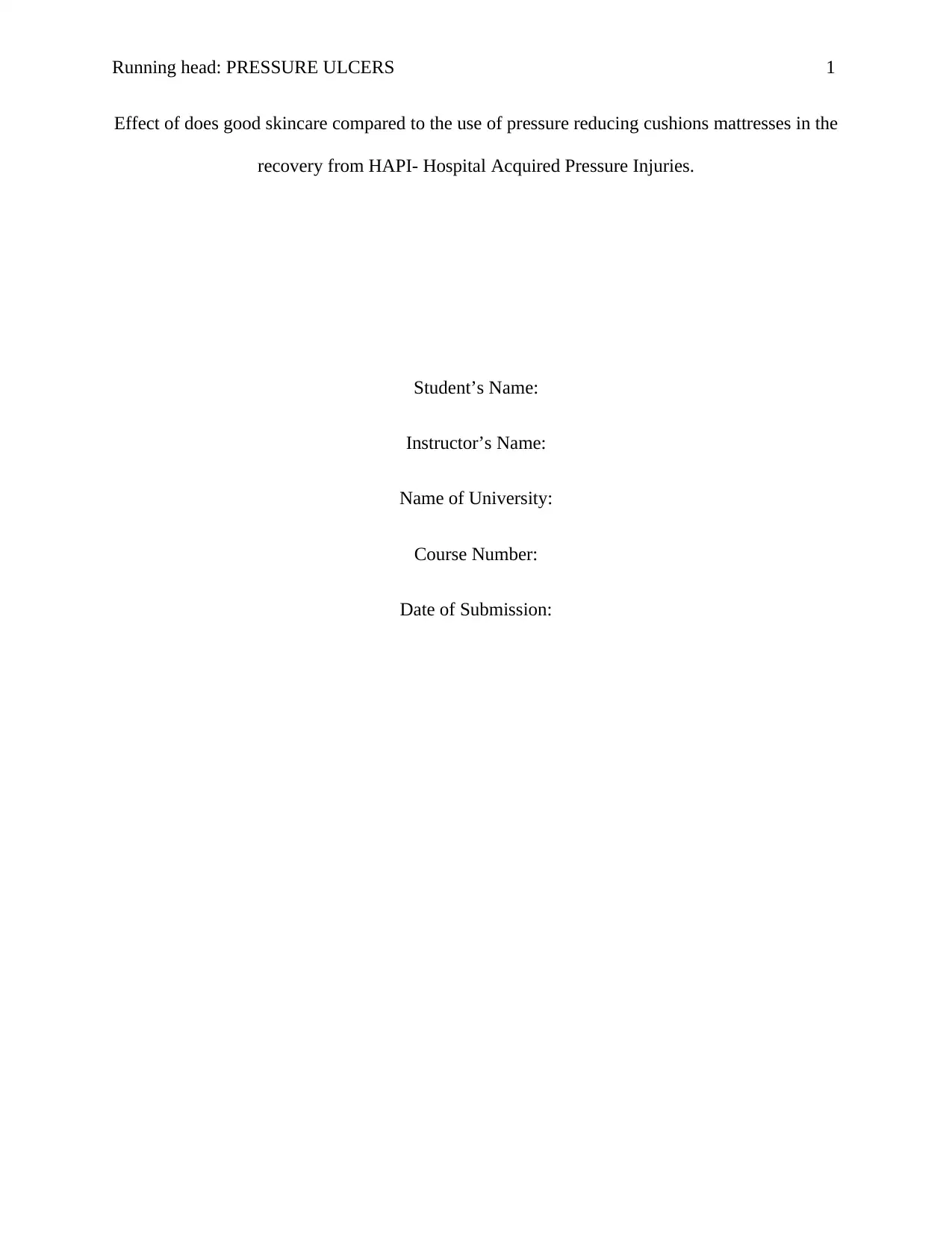
Running head: PRESSURE ULCERS 1
Effect of does good skincare compared to the use of pressure reducing cushions mattresses in the
recovery from HAPI- Hospital Acquired Pressure Injuries.
Student’s Name:
Instructor’s Name:
Name of University:
Course Number:
Date of Submission:
Effect of does good skincare compared to the use of pressure reducing cushions mattresses in the
recovery from HAPI- Hospital Acquired Pressure Injuries.
Student’s Name:
Instructor’s Name:
Name of University:
Course Number:
Date of Submission:
Paraphrase This Document
Need a fresh take? Get an instant paraphrase of this document with our AI Paraphraser
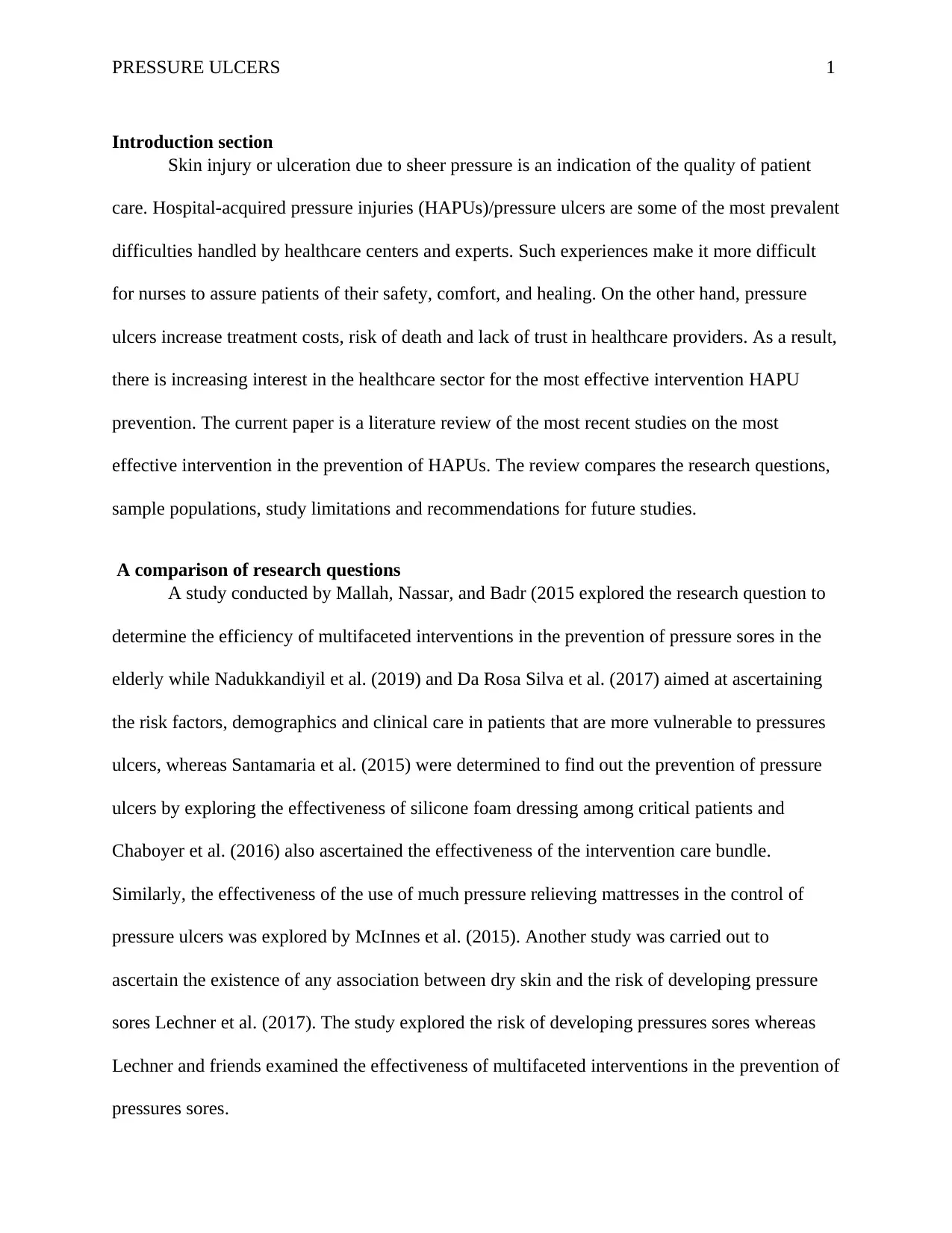
PRESSURE ULCERS 1
Introduction section
Skin injury or ulceration due to sheer pressure is an indication of the quality of patient
care. Hospital-acquired pressure injuries (HAPUs)/pressure ulcers are some of the most prevalent
difficulties handled by healthcare centers and experts. Such experiences make it more difficult
for nurses to assure patients of their safety, comfort, and healing. On the other hand, pressure
ulcers increase treatment costs, risk of death and lack of trust in healthcare providers. As a result,
there is increasing interest in the healthcare sector for the most effective intervention HAPU
prevention. The current paper is a literature review of the most recent studies on the most
effective intervention in the prevention of HAPUs. The review compares the research questions,
sample populations, study limitations and recommendations for future studies.
A comparison of research questions
A study conducted by Mallah, Nassar, and Badr (2015 explored the research question to
determine the efficiency of multifaceted interventions in the prevention of pressure sores in the
elderly while Nadukkandiyil et al. (2019) and Da Rosa Silva et al. (2017) aimed at ascertaining
the risk factors, demographics and clinical care in patients that are more vulnerable to pressures
ulcers, whereas Santamaria et al. (2015) were determined to find out the prevention of pressure
ulcers by exploring the effectiveness of silicone foam dressing among critical patients and
Chaboyer et al. (2016) also ascertained the effectiveness of the intervention care bundle.
Similarly, the effectiveness of the use of much pressure relieving mattresses in the control of
pressure ulcers was explored by McInnes et al. (2015). Another study was carried out to
ascertain the existence of any association between dry skin and the risk of developing pressure
sores Lechner et al. (2017). The study explored the risk of developing pressures sores whereas
Lechner and friends examined the effectiveness of multifaceted interventions in the prevention of
pressures sores.
Introduction section
Skin injury or ulceration due to sheer pressure is an indication of the quality of patient
care. Hospital-acquired pressure injuries (HAPUs)/pressure ulcers are some of the most prevalent
difficulties handled by healthcare centers and experts. Such experiences make it more difficult
for nurses to assure patients of their safety, comfort, and healing. On the other hand, pressure
ulcers increase treatment costs, risk of death and lack of trust in healthcare providers. As a result,
there is increasing interest in the healthcare sector for the most effective intervention HAPU
prevention. The current paper is a literature review of the most recent studies on the most
effective intervention in the prevention of HAPUs. The review compares the research questions,
sample populations, study limitations and recommendations for future studies.
A comparison of research questions
A study conducted by Mallah, Nassar, and Badr (2015 explored the research question to
determine the efficiency of multifaceted interventions in the prevention of pressure sores in the
elderly while Nadukkandiyil et al. (2019) and Da Rosa Silva et al. (2017) aimed at ascertaining
the risk factors, demographics and clinical care in patients that are more vulnerable to pressures
ulcers, whereas Santamaria et al. (2015) were determined to find out the prevention of pressure
ulcers by exploring the effectiveness of silicone foam dressing among critical patients and
Chaboyer et al. (2016) also ascertained the effectiveness of the intervention care bundle.
Similarly, the effectiveness of the use of much pressure relieving mattresses in the control of
pressure ulcers was explored by McInnes et al. (2015). Another study was carried out to
ascertain the existence of any association between dry skin and the risk of developing pressure
sores Lechner et al. (2017). The study explored the risk of developing pressures sores whereas
Lechner and friends examined the effectiveness of multifaceted interventions in the prevention of
pressures sores.
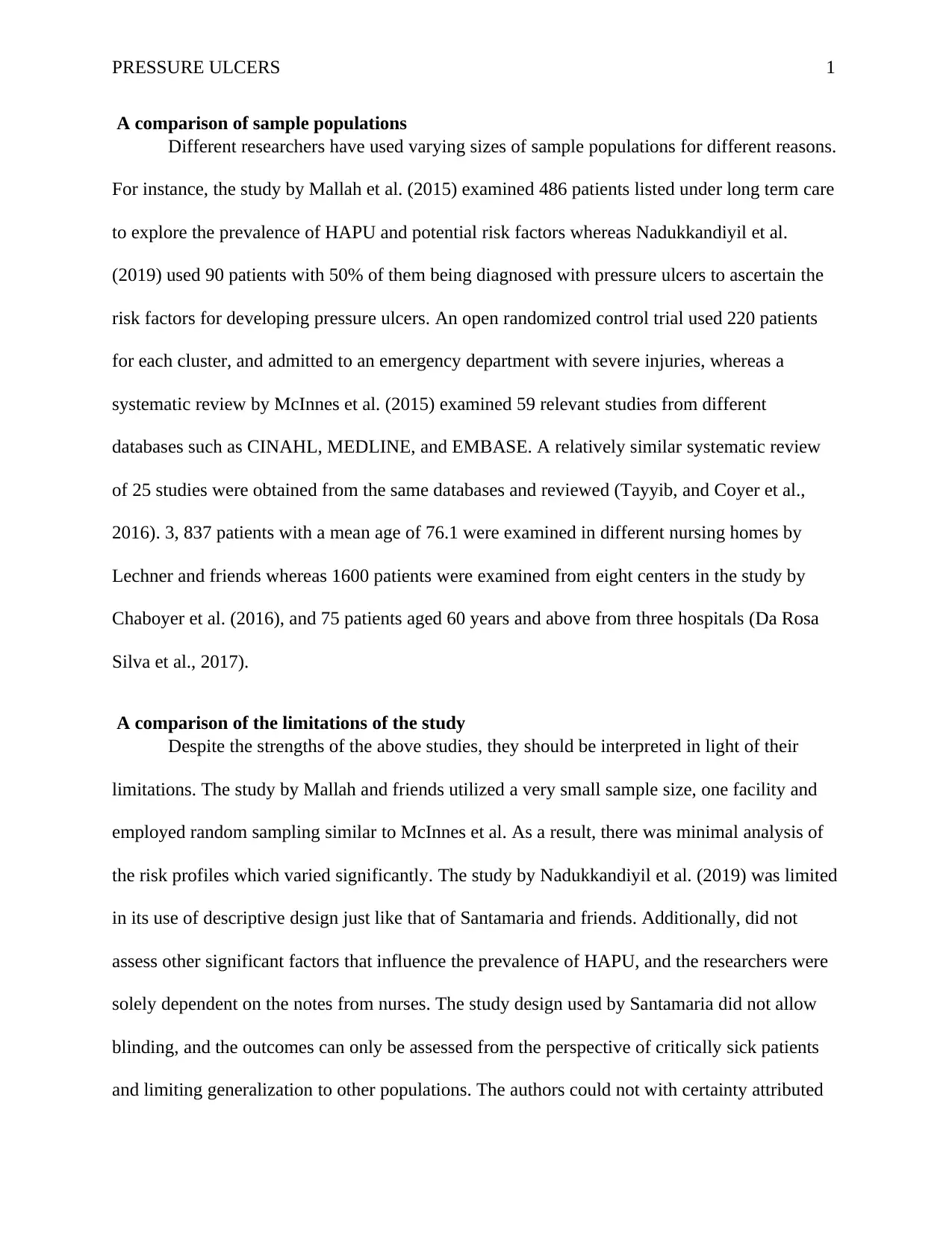
PRESSURE ULCERS 1
A comparison of sample populations
Different researchers have used varying sizes of sample populations for different reasons.
For instance, the study by Mallah et al. (2015) examined 486 patients listed under long term care
to explore the prevalence of HAPU and potential risk factors whereas Nadukkandiyil et al.
(2019) used 90 patients with 50% of them being diagnosed with pressure ulcers to ascertain the
risk factors for developing pressure ulcers. An open randomized control trial used 220 patients
for each cluster, and admitted to an emergency department with severe injuries, whereas a
systematic review by McInnes et al. (2015) examined 59 relevant studies from different
databases such as CINAHL, MEDLINE, and EMBASE. A relatively similar systematic review
of 25 studies were obtained from the same databases and reviewed (Tayyib, and Coyer et al.,
2016). 3, 837 patients with a mean age of 76.1 were examined in different nursing homes by
Lechner and friends whereas 1600 patients were examined from eight centers in the study by
Chaboyer et al. (2016), and 75 patients aged 60 years and above from three hospitals (Da Rosa
Silva et al., 2017).
A comparison of the limitations of the study
Despite the strengths of the above studies, they should be interpreted in light of their
limitations. The study by Mallah and friends utilized a very small sample size, one facility and
employed random sampling similar to McInnes et al. As a result, there was minimal analysis of
the risk profiles which varied significantly. The study by Nadukkandiyil et al. (2019) was limited
in its use of descriptive design just like that of Santamaria and friends. Additionally, did not
assess other significant factors that influence the prevalence of HAPU, and the researchers were
solely dependent on the notes from nurses. The study design used by Santamaria did not allow
blinding, and the outcomes can only be assessed from the perspective of critically sick patients
and limiting generalization to other populations. The authors could not with certainty attributed
A comparison of sample populations
Different researchers have used varying sizes of sample populations for different reasons.
For instance, the study by Mallah et al. (2015) examined 486 patients listed under long term care
to explore the prevalence of HAPU and potential risk factors whereas Nadukkandiyil et al.
(2019) used 90 patients with 50% of them being diagnosed with pressure ulcers to ascertain the
risk factors for developing pressure ulcers. An open randomized control trial used 220 patients
for each cluster, and admitted to an emergency department with severe injuries, whereas a
systematic review by McInnes et al. (2015) examined 59 relevant studies from different
databases such as CINAHL, MEDLINE, and EMBASE. A relatively similar systematic review
of 25 studies were obtained from the same databases and reviewed (Tayyib, and Coyer et al.,
2016). 3, 837 patients with a mean age of 76.1 were examined in different nursing homes by
Lechner and friends whereas 1600 patients were examined from eight centers in the study by
Chaboyer et al. (2016), and 75 patients aged 60 years and above from three hospitals (Da Rosa
Silva et al., 2017).
A comparison of the limitations of the study
Despite the strengths of the above studies, they should be interpreted in light of their
limitations. The study by Mallah and friends utilized a very small sample size, one facility and
employed random sampling similar to McInnes et al. As a result, there was minimal analysis of
the risk profiles which varied significantly. The study by Nadukkandiyil et al. (2019) was limited
in its use of descriptive design just like that of Santamaria and friends. Additionally, did not
assess other significant factors that influence the prevalence of HAPU, and the researchers were
solely dependent on the notes from nurses. The study design used by Santamaria did not allow
blinding, and the outcomes can only be assessed from the perspective of critically sick patients
and limiting generalization to other populations. The authors could not with certainty attributed
⊘ This is a preview!⊘
Do you want full access?
Subscribe today to unlock all pages.

Trusted by 1+ million students worldwide
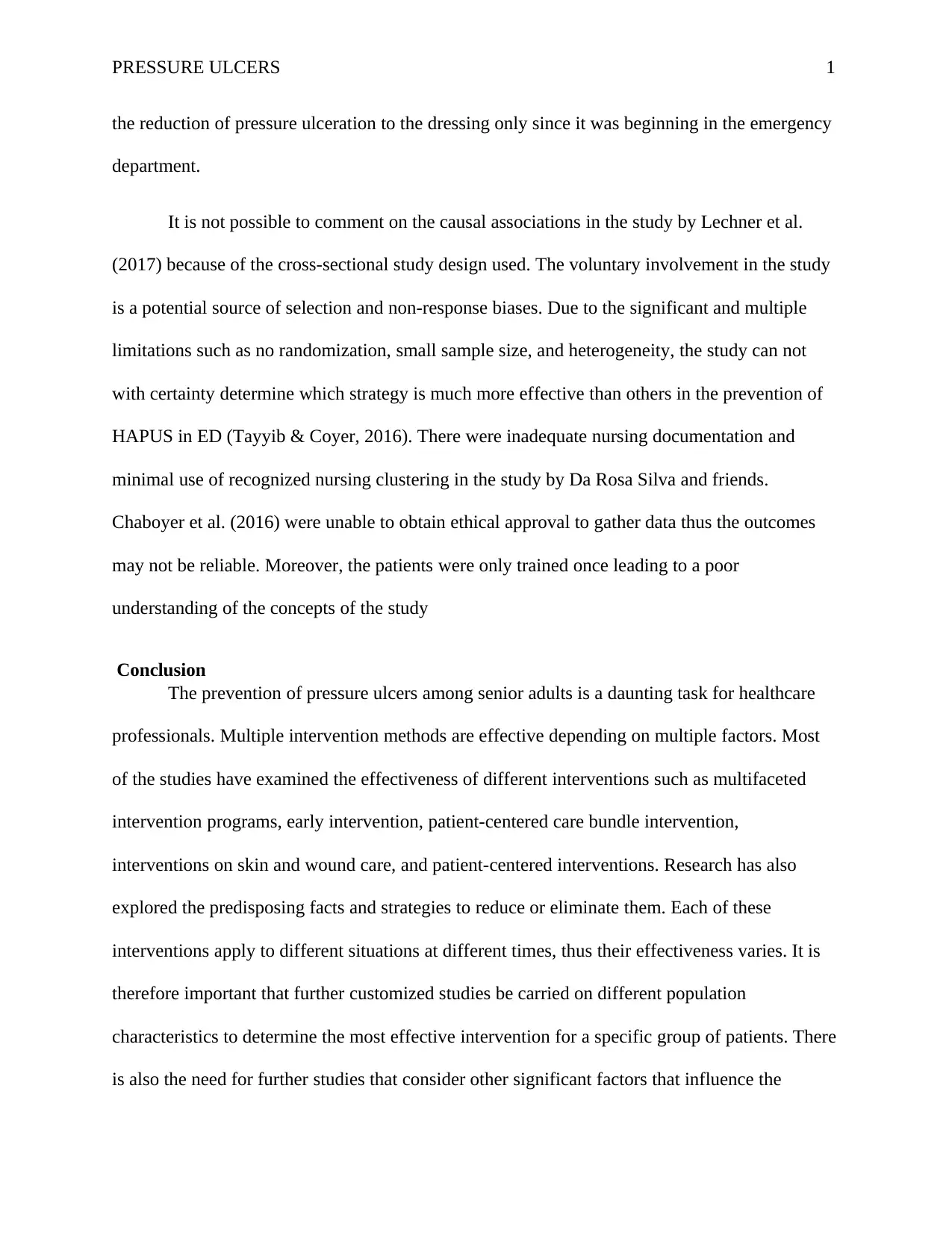
PRESSURE ULCERS 1
the reduction of pressure ulceration to the dressing only since it was beginning in the emergency
department.
It is not possible to comment on the causal associations in the study by Lechner et al.
(2017) because of the cross-sectional study design used. The voluntary involvement in the study
is a potential source of selection and non-response biases. Due to the significant and multiple
limitations such as no randomization, small sample size, and heterogeneity, the study can not
with certainty determine which strategy is much more effective than others in the prevention of
HAPUS in ED (Tayyib & Coyer, 2016). There were inadequate nursing documentation and
minimal use of recognized nursing clustering in the study by Da Rosa Silva and friends.
Chaboyer et al. (2016) were unable to obtain ethical approval to gather data thus the outcomes
may not be reliable. Moreover, the patients were only trained once leading to a poor
understanding of the concepts of the study
Conclusion
The prevention of pressure ulcers among senior adults is a daunting task for healthcare
professionals. Multiple intervention methods are effective depending on multiple factors. Most
of the studies have examined the effectiveness of different interventions such as multifaceted
intervention programs, early intervention, patient-centered care bundle intervention,
interventions on skin and wound care, and patient-centered interventions. Research has also
explored the predisposing facts and strategies to reduce or eliminate them. Each of these
interventions apply to different situations at different times, thus their effectiveness varies. It is
therefore important that further customized studies be carried on different population
characteristics to determine the most effective intervention for a specific group of patients. There
is also the need for further studies that consider other significant factors that influence the
the reduction of pressure ulceration to the dressing only since it was beginning in the emergency
department.
It is not possible to comment on the causal associations in the study by Lechner et al.
(2017) because of the cross-sectional study design used. The voluntary involvement in the study
is a potential source of selection and non-response biases. Due to the significant and multiple
limitations such as no randomization, small sample size, and heterogeneity, the study can not
with certainty determine which strategy is much more effective than others in the prevention of
HAPUS in ED (Tayyib & Coyer, 2016). There were inadequate nursing documentation and
minimal use of recognized nursing clustering in the study by Da Rosa Silva and friends.
Chaboyer et al. (2016) were unable to obtain ethical approval to gather data thus the outcomes
may not be reliable. Moreover, the patients were only trained once leading to a poor
understanding of the concepts of the study
Conclusion
The prevention of pressure ulcers among senior adults is a daunting task for healthcare
professionals. Multiple intervention methods are effective depending on multiple factors. Most
of the studies have examined the effectiveness of different interventions such as multifaceted
intervention programs, early intervention, patient-centered care bundle intervention,
interventions on skin and wound care, and patient-centered interventions. Research has also
explored the predisposing facts and strategies to reduce or eliminate them. Each of these
interventions apply to different situations at different times, thus their effectiveness varies. It is
therefore important that further customized studies be carried on different population
characteristics to determine the most effective intervention for a specific group of patients. There
is also the need for further studies that consider other significant factors that influence the
Paraphrase This Document
Need a fresh take? Get an instant paraphrase of this document with our AI Paraphraser
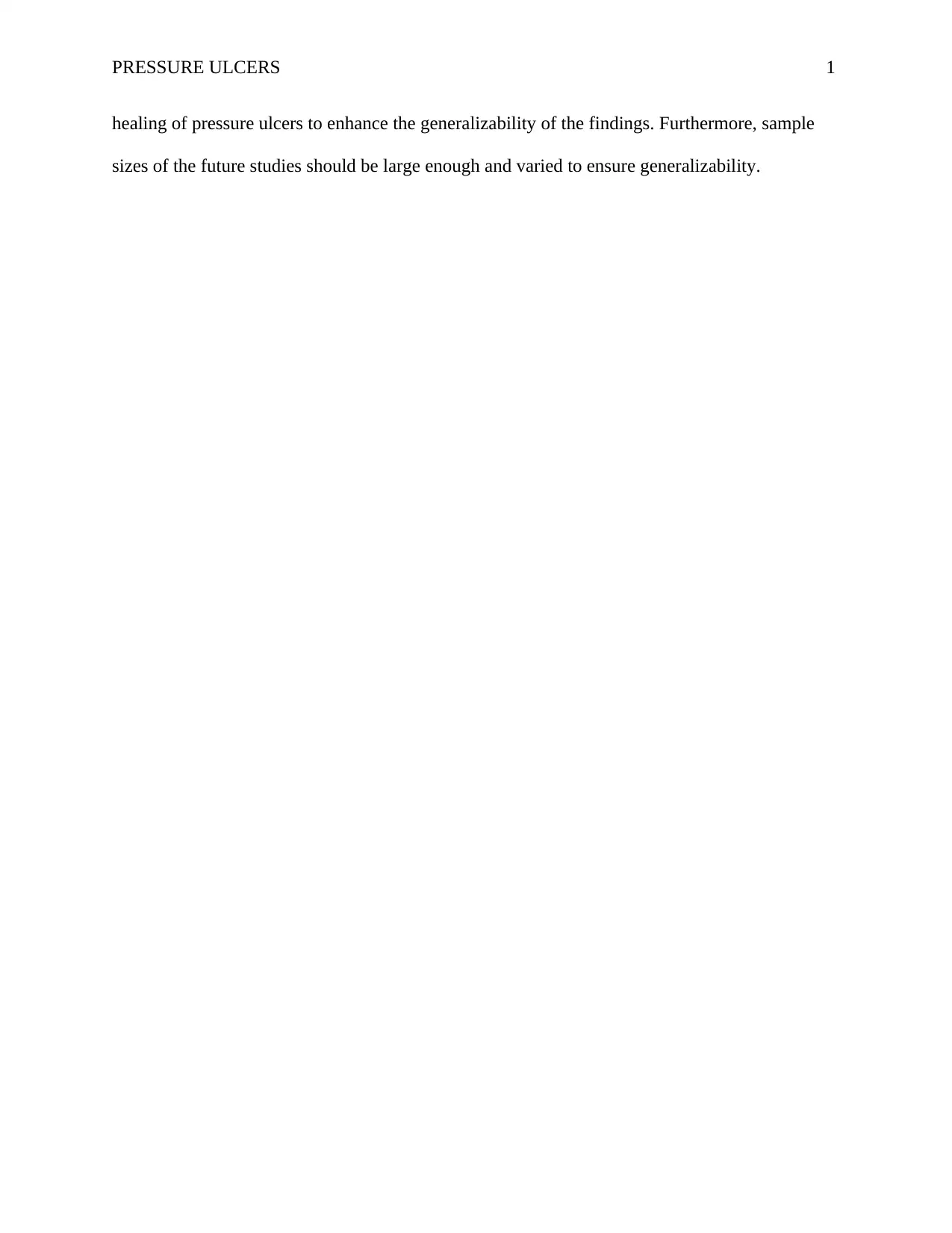
PRESSURE ULCERS 1
healing of pressure ulcers to enhance the generalizability of the findings. Furthermore, sample
sizes of the future studies should be large enough and varied to ensure generalizability.
healing of pressure ulcers to enhance the generalizability of the findings. Furthermore, sample
sizes of the future studies should be large enough and varied to ensure generalizability.
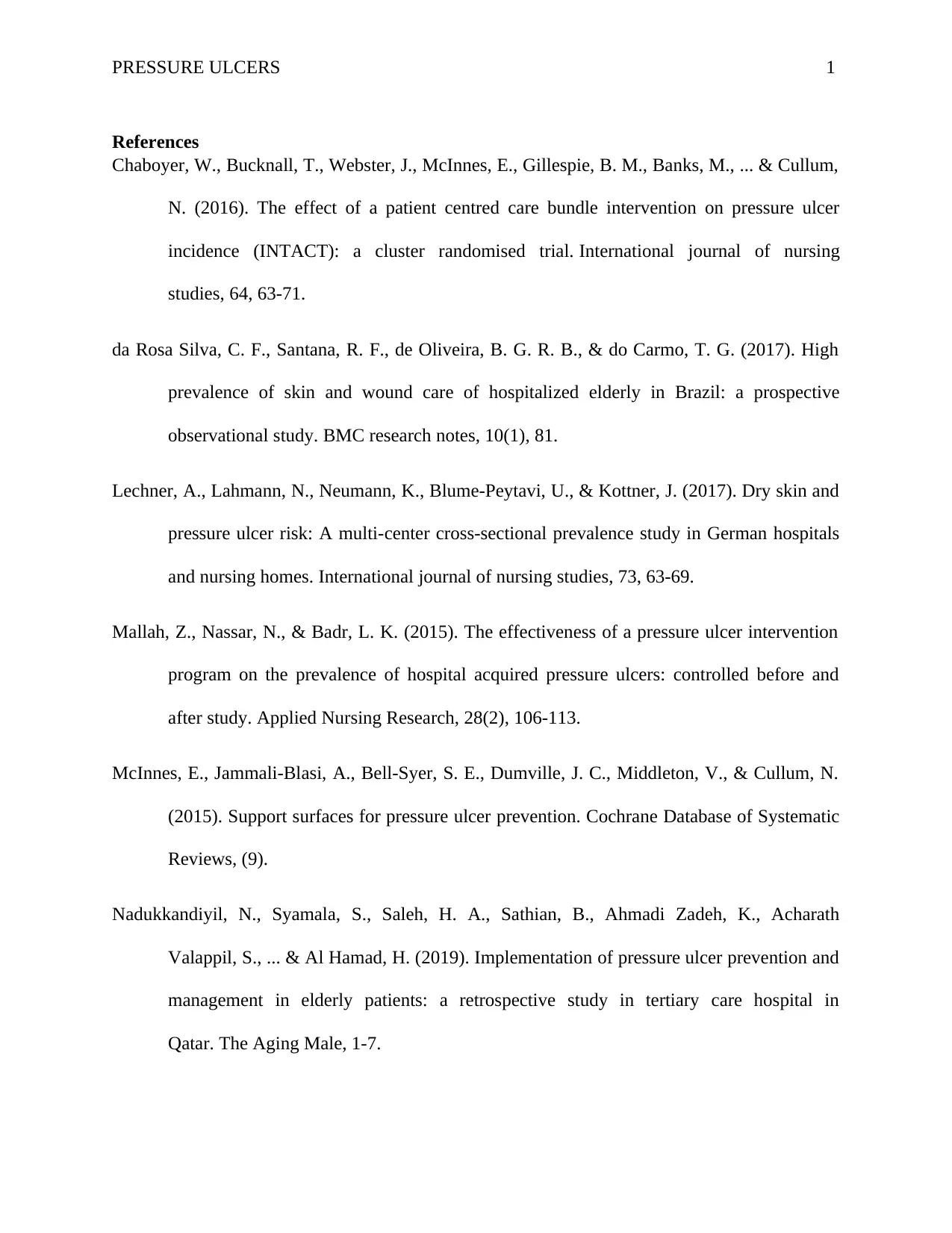
PRESSURE ULCERS 1
References
Chaboyer, W., Bucknall, T., Webster, J., McInnes, E., Gillespie, B. M., Banks, M., ... & Cullum,
N. (2016). The effect of a patient centred care bundle intervention on pressure ulcer
incidence (INTACT): a cluster randomised trial. International journal of nursing
studies, 64, 63-71.
da Rosa Silva, C. F., Santana, R. F., de Oliveira, B. G. R. B., & do Carmo, T. G. (2017). High
prevalence of skin and wound care of hospitalized elderly in Brazil: a prospective
observational study. BMC research notes, 10(1), 81.
Lechner, A., Lahmann, N., Neumann, K., Blume-Peytavi, U., & Kottner, J. (2017). Dry skin and
pressure ulcer risk: A multi-center cross-sectional prevalence study in German hospitals
and nursing homes. International journal of nursing studies, 73, 63-69.
Mallah, Z., Nassar, N., & Badr, L. K. (2015). The effectiveness of a pressure ulcer intervention
program on the prevalence of hospital acquired pressure ulcers: controlled before and
after study. Applied Nursing Research, 28(2), 106-113.
McInnes, E., Jammali‐Blasi, A., Bell‐Syer, S. E., Dumville, J. C., Middleton, V., & Cullum, N.
(2015). Support surfaces for pressure ulcer prevention. Cochrane Database of Systematic
Reviews, (9).
Nadukkandiyil, N., Syamala, S., Saleh, H. A., Sathian, B., Ahmadi Zadeh, K., Acharath
Valappil, S., ... & Al Hamad, H. (2019). Implementation of pressure ulcer prevention and
management in elderly patients: a retrospective study in tertiary care hospital in
Qatar. The Aging Male, 1-7.
References
Chaboyer, W., Bucknall, T., Webster, J., McInnes, E., Gillespie, B. M., Banks, M., ... & Cullum,
N. (2016). The effect of a patient centred care bundle intervention on pressure ulcer
incidence (INTACT): a cluster randomised trial. International journal of nursing
studies, 64, 63-71.
da Rosa Silva, C. F., Santana, R. F., de Oliveira, B. G. R. B., & do Carmo, T. G. (2017). High
prevalence of skin and wound care of hospitalized elderly in Brazil: a prospective
observational study. BMC research notes, 10(1), 81.
Lechner, A., Lahmann, N., Neumann, K., Blume-Peytavi, U., & Kottner, J. (2017). Dry skin and
pressure ulcer risk: A multi-center cross-sectional prevalence study in German hospitals
and nursing homes. International journal of nursing studies, 73, 63-69.
Mallah, Z., Nassar, N., & Badr, L. K. (2015). The effectiveness of a pressure ulcer intervention
program on the prevalence of hospital acquired pressure ulcers: controlled before and
after study. Applied Nursing Research, 28(2), 106-113.
McInnes, E., Jammali‐Blasi, A., Bell‐Syer, S. E., Dumville, J. C., Middleton, V., & Cullum, N.
(2015). Support surfaces for pressure ulcer prevention. Cochrane Database of Systematic
Reviews, (9).
Nadukkandiyil, N., Syamala, S., Saleh, H. A., Sathian, B., Ahmadi Zadeh, K., Acharath
Valappil, S., ... & Al Hamad, H. (2019). Implementation of pressure ulcer prevention and
management in elderly patients: a retrospective study in tertiary care hospital in
Qatar. The Aging Male, 1-7.
⊘ This is a preview!⊘
Do you want full access?
Subscribe today to unlock all pages.

Trusted by 1+ million students worldwide
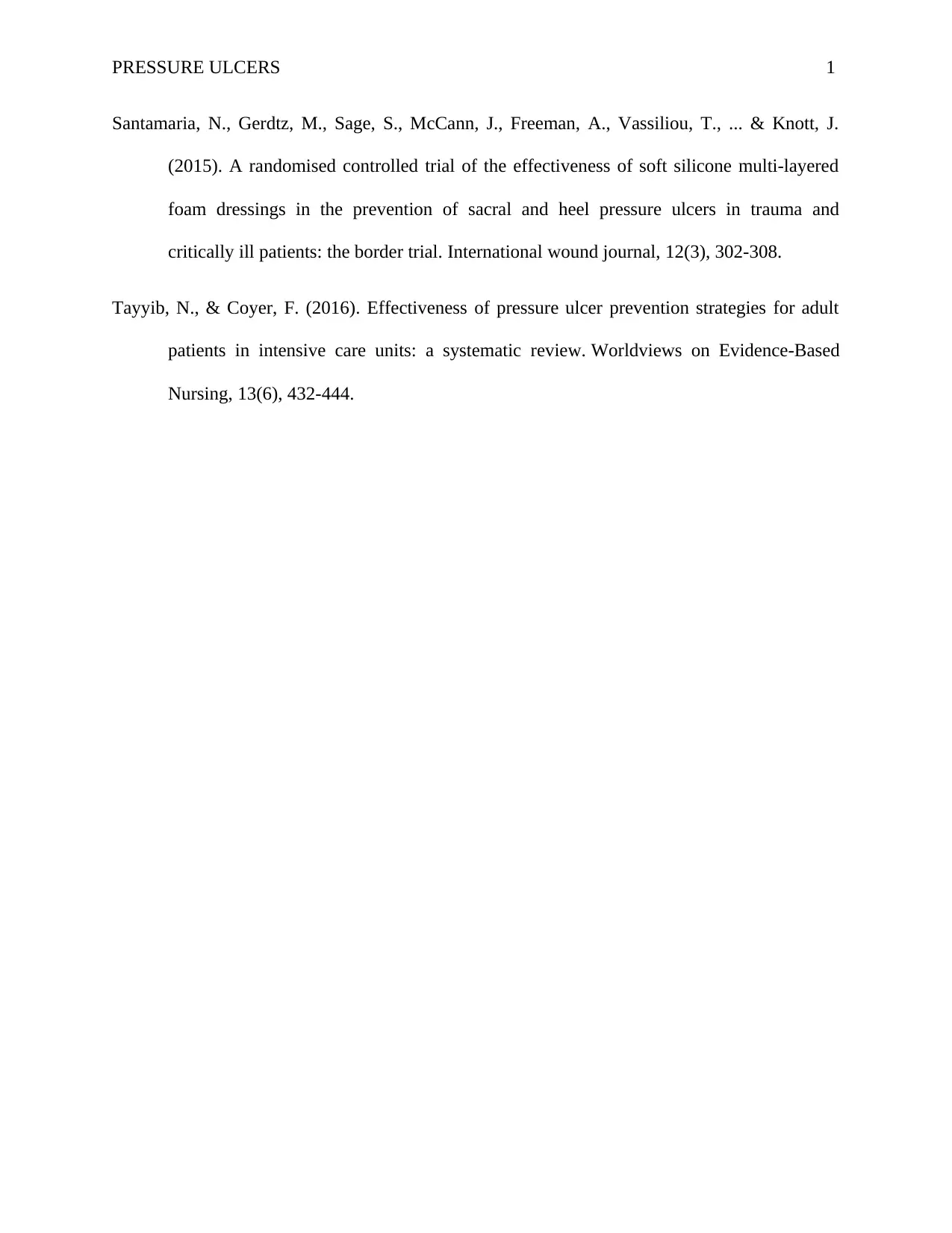
PRESSURE ULCERS 1
Santamaria, N., Gerdtz, M., Sage, S., McCann, J., Freeman, A., Vassiliou, T., ... & Knott, J.
(2015). A randomised controlled trial of the effectiveness of soft silicone multi‐layered
foam dressings in the prevention of sacral and heel pressure ulcers in trauma and
critically ill patients: the border trial. International wound journal, 12(3), 302-308.
Tayyib, N., & Coyer, F. (2016). Effectiveness of pressure ulcer prevention strategies for adult
patients in intensive care units: a systematic review. Worldviews on Evidence‐Based
Nursing, 13(6), 432-444.
Santamaria, N., Gerdtz, M., Sage, S., McCann, J., Freeman, A., Vassiliou, T., ... & Knott, J.
(2015). A randomised controlled trial of the effectiveness of soft silicone multi‐layered
foam dressings in the prevention of sacral and heel pressure ulcers in trauma and
critically ill patients: the border trial. International wound journal, 12(3), 302-308.
Tayyib, N., & Coyer, F. (2016). Effectiveness of pressure ulcer prevention strategies for adult
patients in intensive care units: a systematic review. Worldviews on Evidence‐Based
Nursing, 13(6), 432-444.
1 out of 7
Related Documents
Your All-in-One AI-Powered Toolkit for Academic Success.
+13062052269
info@desklib.com
Available 24*7 on WhatsApp / Email
![[object Object]](/_next/static/media/star-bottom.7253800d.svg)
Unlock your academic potential
Copyright © 2020–2025 A2Z Services. All Rights Reserved. Developed and managed by ZUCOL.





